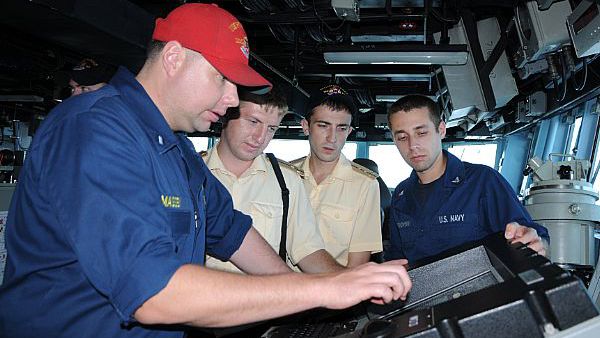Rowden: Navy Will Bring Back Maneuvering Boards

Vice Admiral Thomas Rowden, the commander of U.S. naval surface forces, announced Wednesday that the service will implement common standing orders for bridge and engineering watchstanders across the fleet. Rowden said that the orders will accommodate variations in vessel-specific equipment, but they will "provide common business rules for all bridge [and combat information center] watchstanders."
The announcement follows shortly after news of Rowden's early retirement. He is said to have requested permission to depart the Navy several months ahead of schedule for reasons which have not been released.
Among other measures, the fleet-wide standing orders will add an additional duty for watchstanders. Bridge and CIC watches now have to calculate maneuvering board solutions for all surface contacts with an initial CPA of 5,000 yards or less – suggesting a large number of plots during transits in congested waters.
In modern commercial navigation, maneuvering boards have been supplanted by the Automatic Radar Plotting Aid (ARPA). Stand-alone ARPA units began to replace manual plotting for collision avoidance in the 1970s and 1980s, and today most ARPAs are sold as an integrated radar display, making them synonymous with navigational radar on the modern bridge. The method of manually plotting CPA on a maneuvering board generally requires at least two range and bearing readings at intervals of five minutes or more. By contrast, for targets that are not maneuvering, an ARPA can calculate CPAs for all traffic simultaneously with a maximum time lag of three minutes. ARPA's purpose is to "reduce the workload of observers by enabling them to automatically obtain information so that they can perform as well with multiple targets as they can by manually plotting a single target," according to IMO.
The standing orders also require sailors to complete a bridge resource management (BRM) course within four months, with priority given to vessels that are preparing for upcoming deployments. Currently-deployed vessels are exempt.
Rowden made it clear that commanding officers and their superiors were personally responsible for ensuring the readiness, training and competence of their crews. "Command obligates you to ensure the optimal match of 'talent to task," he wrote. "Inherent within this tenet is your obligation to ensure the manning, material readiness and training necessary to cultivate and equip that talent . . . For commanding officers, I expect the level of personal involvement and fortitude necessary to achieve and sustain these standards."
Rowden also announced that the Navy will institute circadian rhythm-based watch schedules in place of its traditional "five-and-dime" five hour on, ten hour off rotating watchbill. The service has come in for heavy criticism from congressional oversight committees following reports of 100-hour workweeks and high rates of fatigue.
